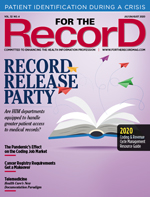July-August  2020
2020
By the Numbers
For The Record
Vol. 32 No. 4 P. 34
48
According to a Checkmarx survey, this percentage of US consumers said they would not opt-in to COVID-19 contact tracing apps, while 23% said they were on the fence, and only 15% said they were extremely likely to opt-in. Consumers’ largest concern was how their data would be used, stored, or shared.
1 Million
Blue Cross Blue Shield of Massachusetts processed more than this number of telehealth claims in the nine weeks after changing its policy to expand coverage for telephone and virtual visits at no cost to members during the COVID-19 crisis. In February 2020, the health plan received approximately 200 telehealth claims per day; in May, it received more than 38,000 per day.
60
According to research by KPMG, 92% of Canadians feel digital contact-tracing apps must balance privacy concerns with public safety, but this percentage would sacrifice their privacy if it helped stop COVID-19.
55
This percentage of Canadians says digital contact tracing should be voluntary, while 45% say government should require individuals to use their smartphones to anonymously share their COVID-19 status as part of contact tracing. However, 57% don’t believe contact tracing would be effective unless it is mandatory, according to research by KPMG.
700
Imperial College Healthcare NHS Trust in England is using Microsoft HoloLens, a mixed-reality headset, with Dynamics 365 Remote Assist to treat patients with COVID-19. A physician wearing the headset and personal protective equipment (PPE) treats the patient while sharing a live video with the health care team in another room, which has led to a decrease in the amount of time staff are spending in high-risk areas of up to 83% and is saving up to this number of PPE items per ward, per week, Microsoft reports.
1/2
As a result of the COVID-19 pandemic, nearly this fraction of physicians used telemedicine for the first time for a physical consultation, and another 43% conducted mental health consultations via telehealth for the first time, according to a survey by Sermo. After the pandemic ends, 61% of physicians plan to use telemedicine for physical or mental health consultations more than they did before COVID-19.
90
According to a survey of 1,392 physicians by Sermo, more than this percentage is conducting some of their patient visits via telehealth.
41.2
According to an article in the Journal of the American Medical Informatics Association, this percentage of all hospitals reported that the most common barrier to public health reporting for the COVID-19 pandemic was that local, state, and federal public health agencies lacked the capacity to electronically receive data.



